3 • The Most Dangerous Game
Three nearly identical letters, each containing one-third of a 408-symbol cryptogram, arrive at three Bay Area newspapers.
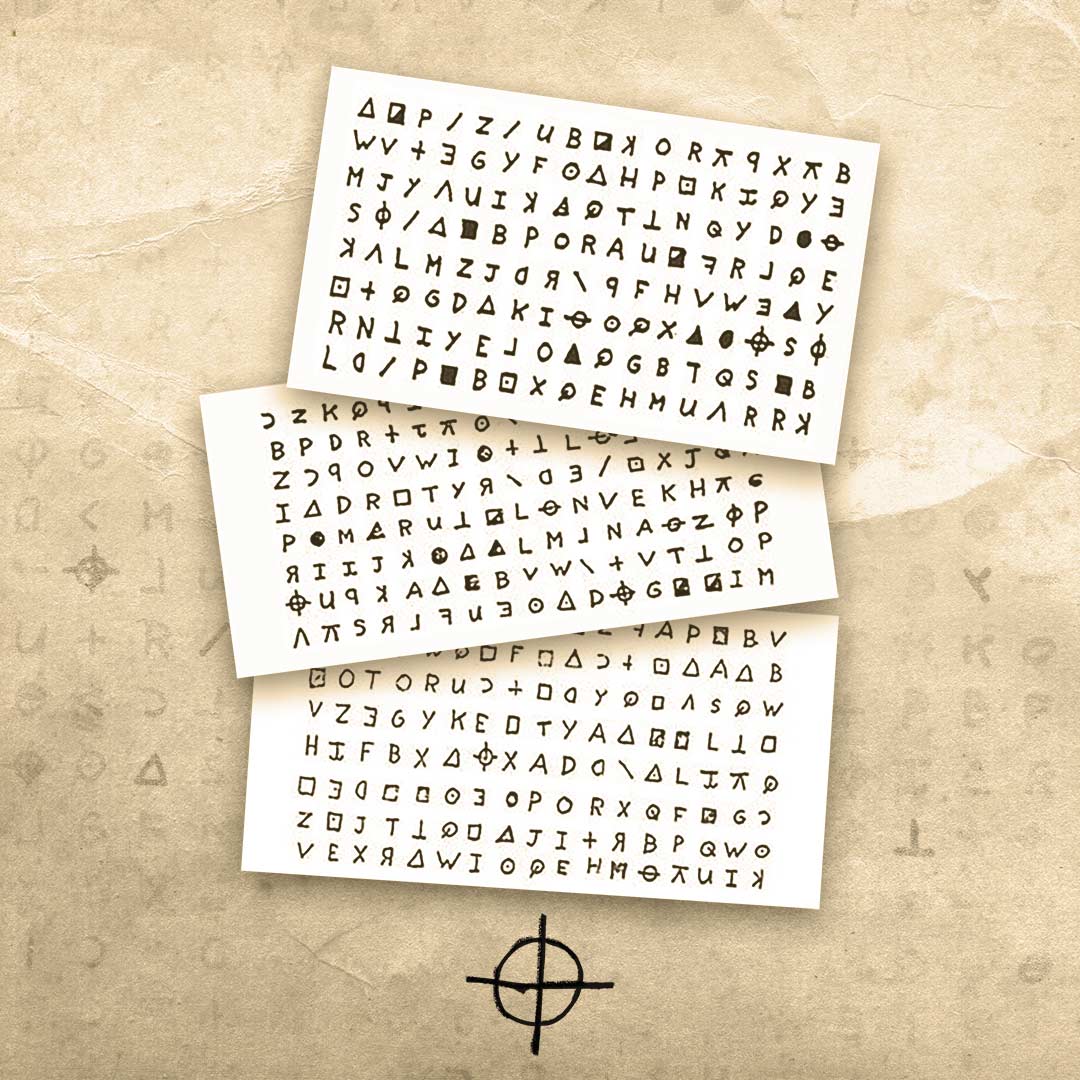

The first letter didn’t cause a lot of consternation, in the sense that nobody knew quite what to make of it. It was viewed really as “Here’s a nutcase playing games. See if you can guess what this is.”
– Duffy Jennings, former employee at the San Francisco Chronicle


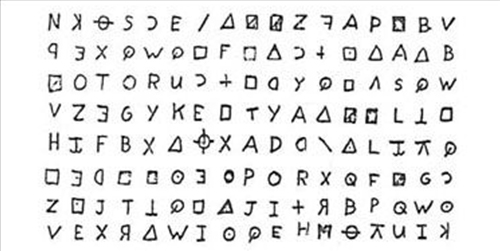
The way he taunted police, there was an element of sadism there. He liked creating fear in the public’s eye. I’m sure that he liked reading about himself in newspapers. That would have been quite gratifying to him. He’ll become kind of like Jack the Ripper.
– Dr. Eric Hickey, professor and author on serial killers
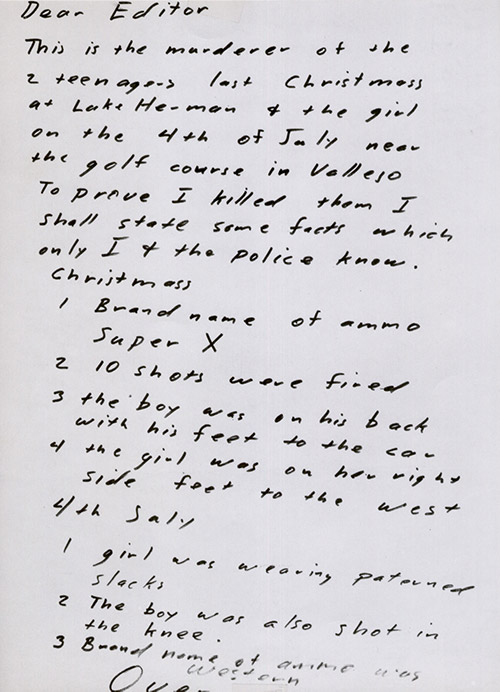
A strange letter arrives at the offices of three Northern California newspapers.
Transcript
Speaker 1: For law enforcement, every homicide case is a puzzle. Some more difficult than others, 200 pieces versus 200,000. The Zodiac Killer took the idea of a puzzle quite literally, forcing everyone to play his little game. This may be what the Zodiac is known for best, codes and taunting letters to press and police. But would there be any answers to his riddle? Any content to his code? Was all this a front, a power play, and not worth the attention he so desperately sought? That was left up to the press. Game on.
Speaker 2: A man in a mask, robbed, tied, and stabbed them, leaving them for dead. Subject stated, “I want to report a murder. No, a double murder. I did it.” A man who wore a medieval-style executioner’s hood carried a knife and gun and intended to use them.
Speaker 3: They haven’t arrested me because they can’t prove a thing. I’m not the damn Zodiac.
Speaker 2: Who is the Zodiac, and where is he?
continue reading
Speaker 1: From iHeartRadio, HowStuffWorks, and Tenderfoot TV, this is “Monster – The Zodiac Killer.”
Speaker 4: When he committed the murders on Lake Herman Road, he didn’t make any effort to communicate with the media or take responsibility for it, but there was a lot of media attention around it. And then when he struck again in July of 1969, there was enormous media coverage, largely because of the phone call he made afterwards where he took credit for that crime and the murders on Lake Herman Road.
Speaker 5: If you will go one mile east on Columbus Parkway, you’ll find kids in a brown car. They were shot with a nine-millimeter luger. I also killed those kids last year.
Speaker 4: So now he’s created this sensational story that there’s a psychotic killer out there, a serial killer who’s responsible for two crimes, not just one.
Speaker 1: 26 days later is when we get the first Zodiac letters.
Speaker 2: A strange letter arrives at the offices of three Northern California newspapers.
Speaker 1: He’s created a whole ‘nother game now.
Speaker 4: On July 31st, 1969, the Zodiac sent envelopes to three Bay Area newspapers. Each envelope included two sheets. A handwritten letter and one-third of a three-part coded message, known as a cryptogram or a cipher. This coded message is very important to the case. But let’s focus on the letter first.
Speaker 1: Duffy Jennings was working at the San Francisco Chronicle when the first letter arrived.
Duffy Jennings: I’ll never forget my first day walking into the Chronicle. The day before I had come in to do an interview but it in the morning and there’s not a lot of activity. You know, most of the activity at a morning paper’s late afternoon.
Duffy Jennings: When I came in to start work the next afternoon, I think it was probably two o’clock. It was equivalent to the first time I walked into Yankee Stadium and saw that grass everybody talks about, with that first experience and how overwhelming it is, the majesty of it. That’s what I sensed at the Chronicle. It was total chaos. Desks were disheveled and crowded with papers, and there was stuff everywhere, and people were smoking. I could smell pencil shavings, glue, printer’s ink. Lots of people talking loudly and guys yelling, “Copy!” and guys at the desk yelling, “First edition!” It was just a typical day, but that’s how it was every afternoon. The closer it got to five o’clock and people were on deadline, editors were yelling, “You need to explain this” or, “Rewrite this!” or whatever it was. I was captivated by it. I was mesmerized by this. It was just an overwhelming sensory experience, to be in and around this environment.
Duffy Jennings: I would come in and wait to be assigned to cover something. When the first letter came, I was among the copy boys sorting mail. The first letter didn’t cause a lot of consternation, in the sense that nobody knew quite what to make of it. It was viewed really as “Here’s a nutcase playing games. See if you can guess what this is.”
Speaker 4: Here’s a portion of the first letter the Zodiac sent to the San Francisco Chronicle.
Speaker 4: Dear Editor. This is the murderer of the two teenagers last Christmas at Lake Herman. And the girl on the Fourth of July, near the golf course in Vallejo. Here is part of a cipher. The other two parts of the cipher are being mailed to the editors of the Vallejo Times and San Francisco Examiner. I want you to print this cipher on the front page of your paper. In the cipher is my identity. If you do not print this by the afternoon of Friday, August 1st, I will go on a kill rampage Friday night. I will cruise around all weekend killing lone people in the night, then move on to kill again.
Speaker 1: The letter was scrawled in blue felt tip pen. The handwriting was sloppy and cramped, and it was full of misspellings like Christmas with two esses at the end. The style of this writing seemed a strange contrast to the other sheet, an orderly grid of letters and symbols that the killer said contained his true identity.
Speaker 4: When the first letters arrived, it was his introduction to the world. This is who I am. I am the murderer. I’m somebody to be taken seriously. I’m a very dangerous person. And if you don’t do what I tell you to do, there will be real consequences.
Speaker 1: The newspapers weren’t sure if the letter came from the killer, and even if it did, should they publish it? On the one hand, you want to take the threat seriously. On the other, it’s like bargaining with terrorists or printing a mass shooter’s manifesto. Do you really want to reward a killer with attention and give them a platform to spread more fear? Two other papers, the San Francisco Examiner and the Vallejo Times, received nearly identical letters but different parts of the code. So the papers had to decide together whether or not to publish.
Duffy Jennings: When there’s any kind of controversy or question about whether to publish things like this, particularly around threats, my guess is we talked to the other newspapers and said, “Are you gonna publish your third of the cryptogram?” And everybody said, “Yes, we will.” It’s a news story when a killer takes credit, publicly, for what he’s done and then taunts you or the police to solve a puzzle.
Speaker 1: But even that wasn’t a front page story.
Speaker 1: Two days later, on Saturday, August 2nd, the Chronicle ran the story Coded Clue in Murders, with a reproduction of the cipher. The Vallejo police chief was quoted as saying, “We’re not satisfied the letter was written by the murderer,” and he urged whoever wrote the letter to prove he was the killer by sending more details. Perhaps trying to trick the Zodiac into sending something self-incriminating.
Speaker 1: The chief also warned Vallejo residents to, “Avoid lonely places.”
Speaker 4: It wasn’t until the police asked, “Would you send another letter with more details” that the next letter came and said, “This is the Zodiac speaking.”
Speaker 1: On August 4th, 1969, just two days after the Chronicle’s story, a new letter arrived with the same slanted handwriting.
Speaker 4: Dear Editor. This is the Zodiac speaking. In answer to your asking for more details about the good times I’ve had in Vallejo, I shall be very happy to supply even more material. By the way, are the police having a good time with the code? If not, tell them to cheer up. When they do crack it, they will have me.
Speaker 4: Last Christmas, in that episode, the police were wondering as to how I could shoot and hit my victims in the dark. They did not openly state this but implied this by saying it was a well lit night and I could see the silhouettes on the horizon. Bullshit. That area is surrounded by high hills and trees. What I did was tape a small pencil flashlight to the barrel of my gun. If you notice, you’ll see a black or dark spot in the center of the circle of light. When taped to a gun barrel, the bullet will strike exactly in the center of the black dot in the light. All I had to do was spray them as if it was a water hose.
Speaker 4: I was not happy to see that I did not get front page coverage.
Speaker 4: When he sends that second letter, now he’s the Zodiac killer. He has chosen his own name, his own moniker. And, although a lot of serial killers throughout history have nicknames, most don’t choose their nicknames for themselves. So that name had some meaning to him that we don’t know but if you look at the handwriting in the Zodiac letters, especially the ones that accompany the cipher, the handwriting looks very sloppy. It looks kind of rushed and just natural handwriting like I just fired off this letter.
Speaker 4: Then you look at the cipher, it’s very clean and very careful. Each part consisted of a block of symbols, letters from the English language, symbols from astrology and other things. Half-filled circles, backwards letters. They’re tidy and in straight rows. He might have used some sort of graphing paper underneath when he was doing it, to make sure of that, which says something in and of itself about the killer. That tells you right there, this was very important to him. It was more important than the letter. And when you look at the cipher itself, it’s chilling just to look at it because you know there’s something in it, right? Well once you realize what’s in it, it’s even more frightening.
Speaker 4: If he just wanted to brag about what he did, he could do that, and he did in that letter. The cipher is another element of this game he’s playing. It’s not just, “I’m somebody who has to be”
Speaker 6: Of this game, he’s playing. It’s not just, “I’m somebody who has to be taken seriously. I’m dangerous.” It’s also, “I’m really clever, and I have something else I want to say.” If you want to know who I am, you want to understand what I did and why I do what I do, you’re gonna have to work for it. I’m not gonna give you everything.
Speaker 1: The police sent the three-part cipher to the nearby Mirror Island Naval shipyard. There, Navy code breakers rushed to crack the killer’s code and to discover the Zodiac’s true identity before he killed again.
Speaker 7: The published codes stumped hundreds of Amateur cryptographers and several intelligence agencies.
Speaker 1: But surprisingly, it was actually two amateurs who ended up solving it. A school teacher and his wife. Don and Betty Hardin saw the code in the newspaper and just decided to give it a shot. Tom Voigt, who runs the website ZodiacKiller.com, recorded the Hardin’s daughter Leslie at a 2008 conference.
Leslie Hardin: This is a project that began on a Sunday morning, fairly early, went on into the afternoon, into the evening, and through the night. They really became, in my eyes, the perfect code-breaking team because my dad the scientific approach and very logical practices and my mother had some intuition that led them in the direction that they needed to go. My father at some point recognized that he had to go to work the next morning. Not so my mother. She did not sleep and ate very little. The next morning he got up and went off to work, he was a school teacher, came back home, and was probably mildly surprised to find there was no dinner and nothing at all happening in the kitchen. She sat in the chair, and he stood behind her and what really captured my attention for that moment was not the code spread out in front of them at all, it was the look of love on my father’s face as he bent over her and put his arm around her.
Duffy Jennings: Don Hardin, he had a boyhood interest in codes. If it wasn’t for Betty’s persistence, they wouldn’t have finished it.
Speaker 1: That’s David Oranchak. A programmer and amateur cryptographer. He spent the last decade fascinated by the Zodiac’s codes.
Duffy Jennings: The first cipher was a simple substitution cipher. Basically, a simple way to hide a message.
Speaker 1: Essentially you substitute each letter with a different letter. So, to make a cipher for the word kill you might substitute J for K, H for I, and Bs for both Ls. And if you know which letters you substituted, you can then decode JHBB back to KILL. But without knowing which letters were substituted, how do you crack that code? The Hardins started by doing what’s called a frequency analysis.
Duffy Jennings: You count up all the letters and how many times they happen. One of the things about English is that certain letters appear more often than others. In particular, the letter E is the most frequently occurring letter in the English language. And so you can use that information to your advantage when you’re looking at a ciphertext. If you find that, say, the letter V is happening a lot more often than the other letters, then there’s a good chance that it stands for the letter E. But the way the Zodiac made it harder in the first cipher was he would take a common letter like E and instead of assigning one ciphertext letter to it, he assigned seven. Seven different symbols.
Speaker 1: That’s why the Zodiac used backwards letters and astrological symbols. To make his code harder to crack. Undaunted, the Hardins next tried what’s called cribbing. Plugging specific words into the puzzle. On a simpler cryptogram, you could try to figure out short words first.
Duffy Jennings: If the ciphertext has spaces in it then you know that certain words are likely to happen. For instance, if you see a word that only has one letter, then there’s only two words that it can be, A and I. In the first ciphertext he did not use word spaces, so that made it a little harder to solve.
Speaker 1: Still, even without the spaces you can try and guess if certain groups of symbols represent common words.
Duffy Jennings: If you have a right guess and you plug it in, and you do the substitution, other parts of the plain text will come out. So, you’ll see fragments of other words. Like T H E. Well, there’s a lot of words that start with T H E so you might be on to something. And if you made a bad guess, then those fragments will look like nonsense. They’ll be letters that are next to each other that wouldn’t really be next to each other. Z Q R, that guess is probably wrong.
Duffy Jennings: Betty is attributed the insight of thinking that he would start it by talking about himself and so it would start with the letter I and that he would talk about his crimes so he would mention killing. Those intuitions also came from patterns that they observed in the ciphertext. They found symbols that were repeating next to each other. Doing a little research they found, well the common doubled letter in English is LL, LL appears in a lot of words. All, will, and kill. And so, that was a good guess on their part because kill does appear in the missive. So, they tried to plug in those words in different places and eventually found other patterns and then through trial and error were able to crack the code.
Speaker 1: Or at least, almost crack the code. At the very end of the message was a string of letters that so far no one has been able to figure out.
Duffy Jennings: The remaining 18 symbols. It’s just a gibberish sequence of letters that doesn’t make any sense. Zodiac was claiming that his identity was in the message, but when you decode it with the Hardins’ key, it doesn’t say anything about his identity. But since the last 18 are still un-decoded, that’s led to a lot of people thinking, “Well, maybe he did something else. There’s some other process that is different than the key for the rest of the message, and there might be another message in there. Maybe he really did put his identity in there, and it’s hidden somehow in those last 18, and we just haven’t figured it out.”
Speaker 1: Leslie, the Hardins’ daughter, remembers waking up in the middle of the night after her parents cracked the code.
Leslie Hardin: Once the message became clear, it was a very frightening message. I do recall being in my room, coming in and out of sleep, mostly nightmares and scary images because the words that were flowing down the hallway were frightening words. Kill. Dangerous. Animal.
Speaker 1: This is the message that was hidden in the Zodiac’s three-part cipher:
Zodiac: I like killing people because it is so much fun. It is more fun than killing wild game in the forest because man is the most dangerous animal of all. To kill something gives me the most thrilling experience. It is even better than getting your rocks off with a girl. The best part of it is that when I die, I’ll be reborn in paradise and all that I have killed will become my slaves. I will not give you my name because you will try to slow down or stop my collection of slaves for my afterlife.
Leslie Hardin: All of the sudden there’s what looks like a message and the question at hand was, “What do we do now?” They decided that they would do what the paper suggested. The paper said if you think you might have a solution, call this number. So they did, but once they did, it got a whole lot more interesting.
Speaker 1: The decoded message didn’t reveal the Zodiac’s true identity as he had promised, but it did give clues as to who the Zodiac might be.
Duffy Jennings: In the Zodiac’s ciphered message he referred to man as the most dangerous animal of all, which some people have interpreted as a reference to the book and/or the movie The Most Dangerous Game. A lot of us are older, we had to read that story in high school, and if you were a teenager who read that in high school and you were harboring some sort of violent fantasies, then you’re not empathizing with the victims the way most of us do when you read that story. You think about being the hunter. Count Zaroff, who lives on this island where he has constructed things designed to make ships crash on the shore so that people will be deserted on this island.
Speaker 8: I’m not trying to intrude, but I’m in sort of a jam. Are you the owner here?
Count Zaroff: Yes, I am Count Zaroff.
Duffy Jennings: And of course he pretends to be a gracious host and invites them to stay and everything.
Count Zaroff: God made some men kings, some beggars. Me he made a hunter.
Duffy Jennings: Only for them to learn that he really intends to hunt them like animals.
Count Zaroff: Here on my island I hunt the most dangerous game.
Speaker 8: You are a maniac. He take half-drowned men from ships you wrecked and drive them out to be hunted.
Count Zaroff: Only after the kill does man know the true ecstasy of love.
Duffy Jennings: Count Zaroff, obviously the name starts with the letter Z, he wears a costume of sorts, and he stalks his victims like prey. The whole story is structured around the idea that killing is sort of an intellectual exercise. That it’s sort of a right of man to hunt another human being. That killing is part of human nature. And the Zodiac may have been very drawn to a story with those elements. He may have decided to emulate certain aspects of Count Zaroff, and maybe that might explain the difference between those first two attacks, the Blitzkrieg shootings at night. After that, it’s not the same kind of crime because in the story The Most Dangerous Game, Count Zaroff doesn’t come out saying, “I’m going to kill you.” He makes you think that he’s a friendly person. He wants you to participate in his game. He needs you to feel safe so that when you find out that you’re no-
Speaker 4: He needs you to feel safe so that when you find out that you’re no longer safe, he can see that fear in you and that fear is part of the hunt. So I think with the Zodiac there may have been some element of that he decided it’s not enough for me to just shoot these people. I need to talk to them. I need to look in their eyes and see them go, oh everything’s okay now. And then look in their eyes when I flip on them, and they find out that this is not what they thought. And that their lives are at stake.
Speaker 1: Why did the Zodiac quote the villain from what at the time was almost a 50-year-old story. Maybe it’s how he saw himself, a movie villain playing with his victims. There were other possible clues about the Zodiac’s identity hidden in the cipher. Such as this line-
Zodiac: “To kill something gives me the most thrilling experience. It is even better than getting your rocks off with a girl.”
Speaker 1: Psychiatrist at the time speculated that this line reflected the killer’s feelings of sexual inadequacy. But it may have also been literal. The Zodiac maybe a sadist. Someone who feels excitement or pleasure from inflicting pain. To learn more about statism, we spoke with criminal psychology professor, Eric Hickey.
Dr. Eric Hickey: My name is Doctor Eric Hickey. I’m a criminal psychologist. Somedays I’m just a criminal, sometimes just a psychologist.
Speaker 1: Professor Hickey literally wrote the book on serial killers. It’s a textbook called Serial Murderers and Their Victims.
Dr. Eric Hickey: One day I get a phone call from the media, and there was a case of a mass murderer. When they searched his car, they found a couple of books in the backseat of his car. And one of the books was my book on serial murder. They said, “Dr. Hickey, how do you feel about the fact that this serial or mass murderer had your book in his car?” I’m like I’m supposed to feel badly I wrote a book about serial murderers. No. And I said, “Well, why would I be upset about that?” The point is, this is for public education, to make us more aware of these types of people.
Speaker 1: Professor Hickey says, “Two-thirds of serial killers are sexual predators, and many have unusual desires like sadism.” Hickey says, that even though the Zodiac didn’t sexually assault his victims, the killings could have been sexually motivated.”
Dr. Eric Hickey: So statism is what we call a paraphilia. Paraphilia meaning that they get sexual arousement and gratification through bizarre imagery, fantasies, and behavior. There’s hundreds and hundreds of paraphilia. And probably 60% of them are not criminal. And people want to have sex with door knobs, that’s their business. It’s not a crime. A person could have a foot fetish, that’s not a crime. It is a crime, however, if they break into people’s homes and peel off their blankets while they’re asleep and suck on their toes. That’s a crime. So there’s a whole variety of criminal paraphilia that are not physically harmful, but they are still criminal. Like voyeurism, exhibitionism, somnophilia, where you like to watch people sleep. Those are criminal, but nobody gets hurt. But people who are driven to kill serially, those are not the outlets they’re looking for. If you’re a serial killer and you’re sadistic, you’re not into consent. You want to be able to do what you want to do. The Zodiac had no problem killing people and making them suffer as he did it.
Speaker 1: Hickey thinks the Zodiac sadism likely extended beyond the killings, to the letters, the puzzles.
Dr. Eric Hickey: The way he taunted police, there was an element of sadism there. He liked creating fear in the public’s eye. I’m sure that he liked reading about himself in newspapers. That would have been quite gratifying to him. He’ll become kind of like Jack the Ripper.
Speaker 1: Jack the Ripper also sent letters to newspapers when he terrorized London in the late 1800s. One read, “The next job I do, I should clip the ladies ears off and send to the police officers just for jolly.” Many thought it was a hoax until three days later, a woman was found dead. Her earlobes severed.
Dr. Eric Hickey: I think that that was something that the Zodiac was trying to attain was that sort of notoriety. He held the city of San Francisco in fear. It was all his doing, and that would make him feel very powerful. And give him great pleasure in doing it. There was that sort of sadistic approach not just to his victims but also to the general public.
Speaker 1: So the Zodiac is likely a sadist, a term name after the Marquis de Sade. A French philosopher and novelist. Sade wrote in his book, Juliette, “It is an article of faith on the Island of Borneo, that all those persons a man kills will be his slaves in the next world. And as a result the better a man wishes to be served after his death, the more he kills during life.” Which brings us to the end of the cipher.
Zodiac: When I die, I’ll be reborn in paradise. In all that I have killed will become my slaves. I will not give you my name because you will try to slow down or stop my collection of slaves for my afterlife.
Speaker 1: Had the Zodiac read that passage from the Marquis de Sade or heard about these beliefs somewhere else? Either way, this fantasy of slaves in the afterlife speaks to the Zodiac’s intense desire for power and control. The Zodiac’s murders and phone call were cold-hearted. His letters were twisted. But the decoded cipher revealed just how truly deranged the Zodiac was. As San Francisco would soon find out what they’d seen so far was just the beginning. The Zodiac was ramping up. Professor Hickey told us serial killers often intensify their crimes over time.
Dr. Eric Hickey: There was this evolvement with serial killers that we see. There is a long process. Look at Jeffrey Dahmer, nobody wakes up in the morning and says I’m a necrophile. They wake up feeling that they wanted to be with someone who’s been buried. That’s what Dahmer did. He wanted to be with someone who had been buried because he had such low self-esteem, he didn’t feel comfortable being with a live person. And then he progressed wanted to be with blob dolls and mannequins, and so on and then he progressed from that to dead animals.
Dr. Eric Hickey: And then from there he went on to bring people home and when they wanted to leave then he’ll make them unconscious and drill holes in their heads and put mercuric acid in to make them into zombies. And then he progressed from there to eviscerating them and then having sex with the corpses, and he started cannibalizing them. He went down this long, long, dark, dark pathway that each time he did it, his fantasies got more and more evolved.
Speaker 1: Like Jeffrey Dahmer, the Zodiac was also beginning to evolve. His codes would become more complex, his letters increasingly bizarre. And his murders more ritualistic and sadistic. Next time, on Monster, the Zodiac Killer.
Speaker 9: Cecelia Shepard And Bryan Hartnell, both in their early 20s were sitting on this knoll of land overlooking part of Lake Berryessa. They thought they were alone, but there was a third man on this knoll. A man who wore a medieval-style executioners hood carried a knife and gun and intended to use them.
Speaker 10: Whenever we drive here, I’m like, wow, he drove the same exact way just to get here and do that. It’s crazy to think about.
Speaker 11: This guy is a pathological psycho killer.
Speaker 12: Found this young girl laying on the shoreline here. I’ve had 11 years patrolling this lake, and I’ve seen a lot of people cut up by boat accidents but this one of the worse things I’ve ever witnessed.
Speaker 4: Monster, The Zodiac Killer is a 15 episode podcast produced by iHeartRadio, HowStuffWorks, and Tenderfoot TV. Donald Albright and I are executive producers on behalf of Tenderfoot TV. Alongside producers Meredith Stedman, Mason Lindsey, and Christina Dana. Jason Hoch is executive producer on behalf of HowStuffWorks. Along with producers Trevor Young, Miranda Hawkins, Ben Kuebrich, and Josh Thane. Scott Benjamin provides additional voice talent. Matt Frederick is our host. Original music is by Makeup and Vanity Set. If you haven’t already, make sure to check out the first season of Monster, called Atlanta Monster. About the Atlanta child murders in the late ’70s to the early ’80s. Download the 10 episode season right now. Have questions or comments, email us at monster@howstuffworks.com or you can call us at 1-833-285-6667. Thanks for listening.
Episodes
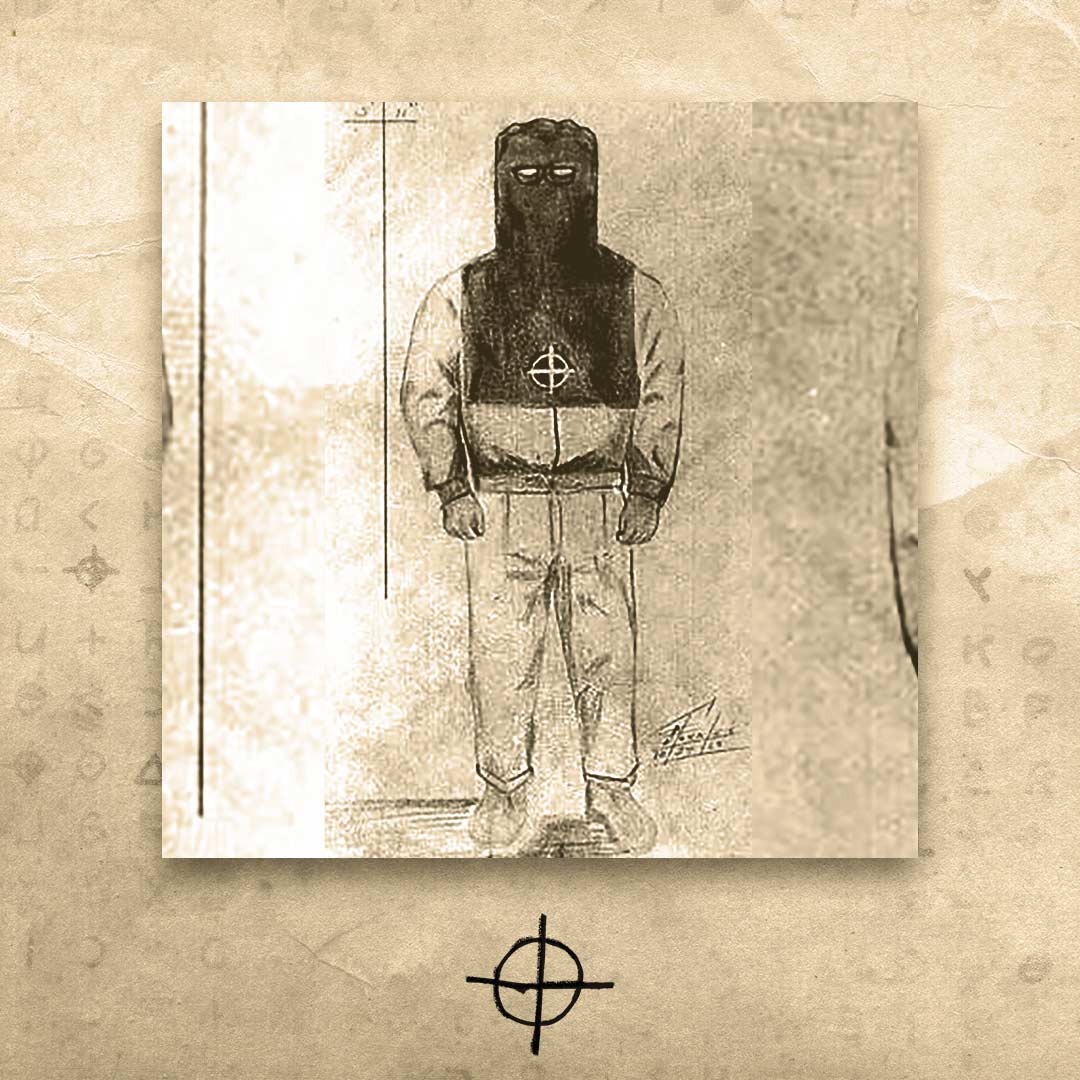
4 · The Lake
Who is this man in a medieval mask?
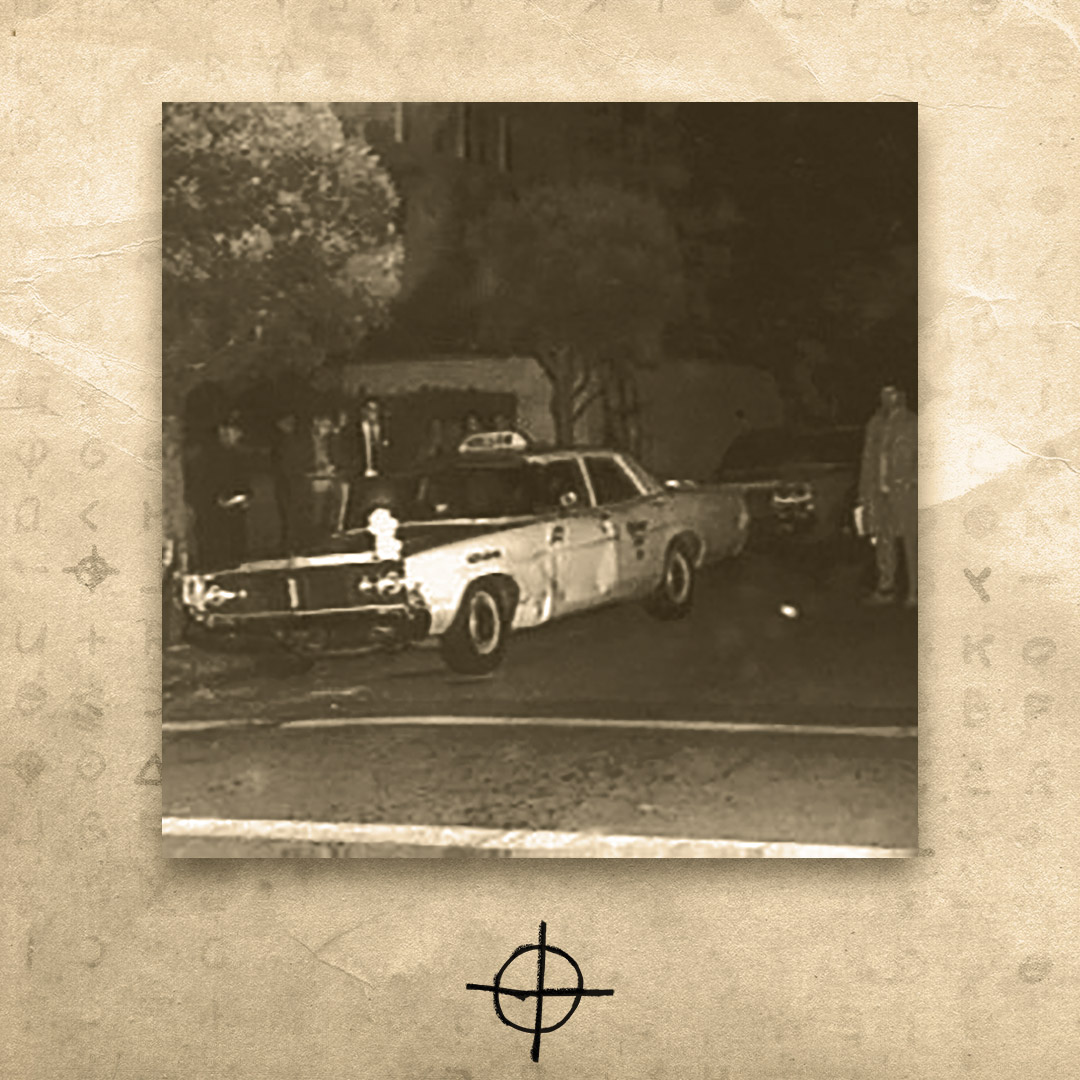
5 · Taxi Driver
Zodiac moves to the City by the Bay.
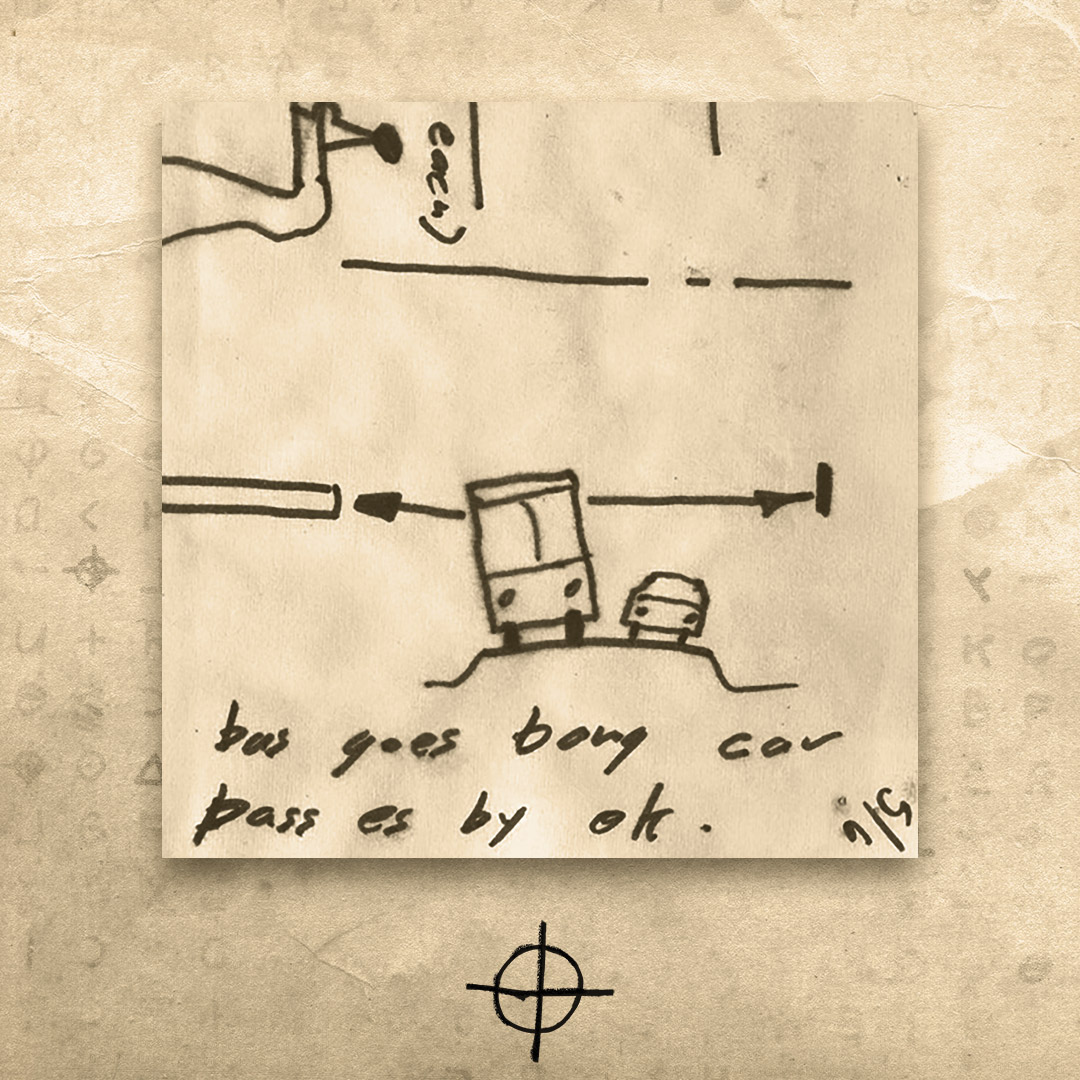
6 · School Bus
Zodiac is making threats which now target children. And he says he’s making a bomb.
